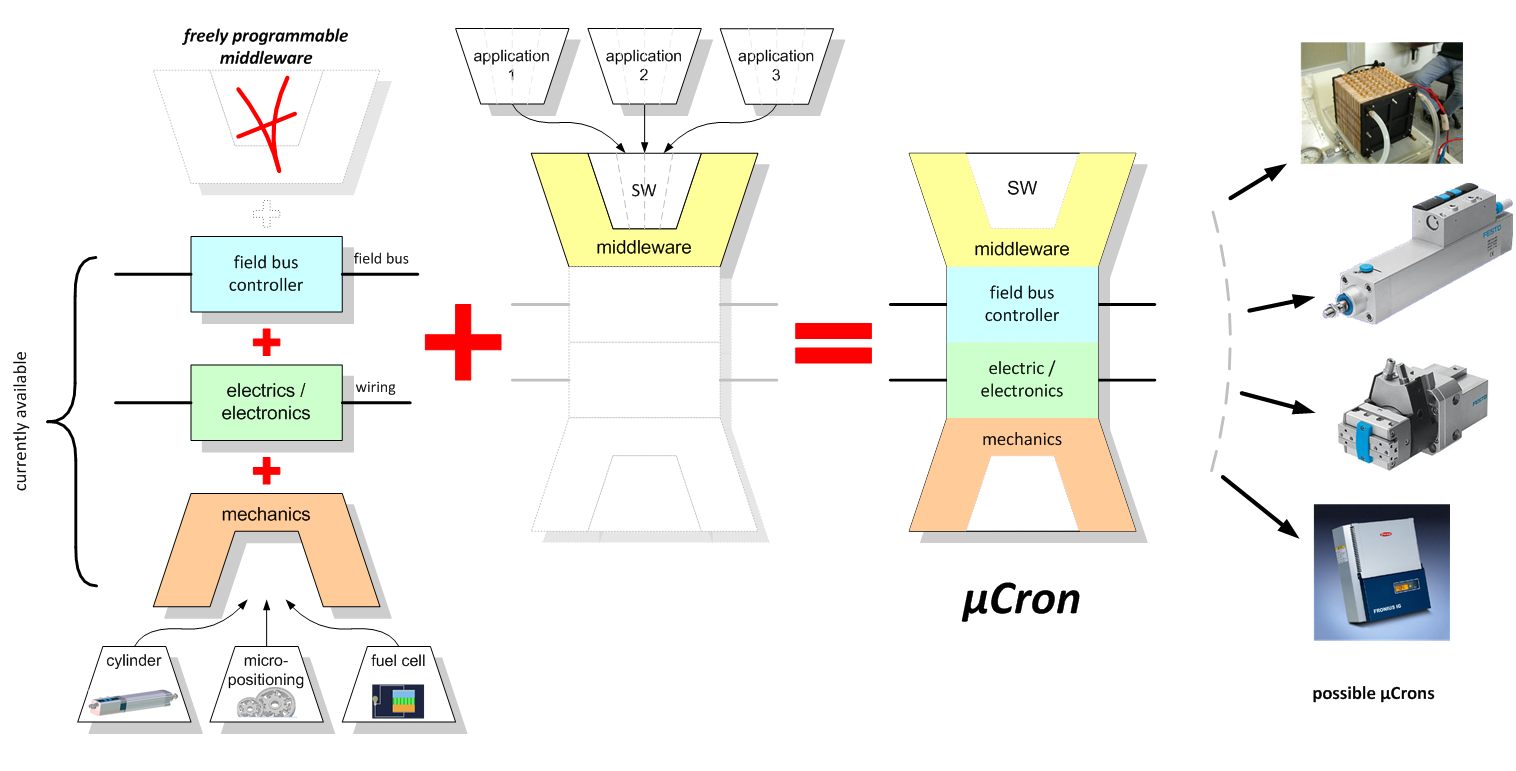µCrons
In order to achieve concepts such as "Flexible Production up to batch size 1", "Customisation" or "Knowledge Economy", we need "agile" system components (mechanical engineering, hardware, software). To that end, both machinery and plant components have to be endowed with fresh characteristics that will extend to the capacity for reconfiguration during operation.
The present state-of-the-art is based on developments that came into being approximately 40 years ago: incompatible with these new requirements. Consequently, new and more agile control concepts ("Next Generation Distributed Embedded Automation and Control Systems") have been developed and applied in the context of this project.
Project goals
The objective of the µCrons project is to develop middleware for flexible, modular electronic components (designated as µCrons) that can be reconfigured and re-allocated in real-time. Because present-day requirements are beyond the grasp of conventional, centrally organised, rigid control structures, there had to be a breakthrough on the road to high-flexibility, failsafe ("Zero Downtime") production systems.
Project results achieved
During the initial project phase, a runtime environment based on IEC 61499 - for microcontrollers with limited resources (CPU, memory, etc.) - was developed as the basis for the µCrons middleware. A prime objective during this phase was to find a software design which would make it plain and simple to transfer onto a range of control hardware. This was achieved by the hardware abstraction layer within the middleware.
In the course of the 2nd project phase, µCrons middleware was expanded with a deterministic processing model for IEC 61499 based control applications. Furthermore, a corresponding engineering approach was developed - which made it possible to add real-time conditions to IEC 61499 applications. Now, "reconfiguration services" have been implemented, and this makes it possible to adjust control software online in a network of various controllers.
Exploitation
In 2007, with the agreement of all project partners, the IEC 61499-based runtime environment was published as an open source project under the name of FORTE (4diac Runtime Environment) and covered by the Eclipse Public License (EPL). Over the years, the runtime environment has been recurrently expanded with fresh functionalities, and migrated onto the widest range of varieties of hardware. This makes the 4diac project (and consequently also the results from the µCrons project) more and more valuable to the widest range of users.
4diac is used worldwide by many universities for research and teaching purposes in the field of distributed automation technology, with IEC 61499 (e.g. Vienna University, Lulea (Sweden), Magdeburg (Germany), Porto (Portugal), Bilbao (Spain), Melbourne (Australia), Calgary (Canada)). More than 100 students are gaining the benefit of 4diac as a learning platform for distributed control technology, at VIENNA UNIVERSITY - ACIN.
And - in addition to its use in education - 4diac is also exploited by various companies.
It was as long ago as the time of the origins of the open source project that the company of nxtControl had begun developing a FORTE-based, successful automation solution with IEC 61499.
Conmeleon is a low-cost open source SPC based on the Raspberry Pi model 2 and model 3. The I/O board was developed by the project group itself. The target user group is in the demanding field of home-based automation, where the emphasis has already been placed on the facility for flexible adaptation to the respective application. It was possible to achieve this objective in the field of open source software using 4diac. The SPC is connected directly from FORTE via the MQTT protocol to openHAB, a Java-based OSGi framework for home-based automation. Consequently, standard commercial smartphones and tablets can be used for control and display.
With meo Energy (Graz, Austria), a further Austrian company is using 4diac as a platform for its control products. meo Energy is developing smart, modular heating system controllers which optimise existing heating systems, in some cases incorporating existing energy storage media and photovoltaic plant into the overall concept, culminating in greater efficiency in the use of energy.
And Austrian Institute of Technology (AIT) has automated its 1 MW Smart Grid Laboratory "SmartEST" on a 4diac basis (which also means building on results already achieved by µCrons). A further application for FORTE is being practised by AIT in various smart grid research & development projects.
NOJA Power, Australia, have come up with a further, attractive application. NOJA is developing and producing low-voltage and medium-voltage switching systems and smart power switches. For this application, FORTE is also used as a design tool within the corresponding controllers and the 4diac development environment.
PROFACTOR have automated a mobile, adaptively operating inspection robot using 4diac. This mobile inspection robot can be applied quickly – and without changing the hardware – for new test pieces and inspection tasks. 4diac is also used as the base technology in the widest range of research projects (such as SYMBIO-TIC, for example). And 4diac is also used at fortiss - a research institute in Munich – as the basic infrastructure for a range of research projects.
4diac was taken on as long ago as April 2015 as an open source project by the Eclipse Foundation. This meant that the visibility profile of 4diac was considerably enhanced, effectively positioning 4diac as an open source project for distributed industrial automation solutions.

